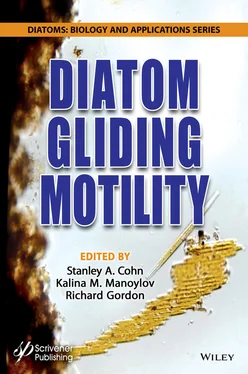10 Chapter 10Figure 10.1 Drawing adapted from O.F. Müller (1783, translated in [10.54]), who was the first to characterize Bacillaria colonies. Examples 1 through 8 show the various states of expansion and contraction (dynamic phenotypes) of colonies.Figure 10.2 Bacillaria close-up images of single cells using scanning electron microscopy (SEM). (a) a whole valve seen from the inside. (b) close up of the same, middle section. The horizontal slit is the raphe. It lacks a central node. (c) Tip of the inside of a valve. (d) Middle section of a valve, exterior view. Note the raphe is a slit through the whole valve. (e): External view of the tip of a valve [10.33]. (Reprinted with permission of Amgueddfa Cymru, National Museum Wales.)Figure 10.3 Demonstration of the image tracking procedure. (a) definition of tracked feature (white ellipse within a cell). (b) labeled (numbered) cells with relative measurements provided in red. The determined coordinates refer to a target in the middle of the template. The target can be moved and placed on the apex of the diatom being tracked. Then the coordinates of the apex are captured. This position is indicated in Figure 10.3a by a mark and a vertical line. Image scale: 38.36 μm per cm, or 0.325 μm per pixel. Scale bars 50 µm.Figure 10.4 A diagram showing the five points on a sample cell (two ends, midpoint of the transverse line, and edges of the cell).Figure 10.5 Point A is on the edge (vertical direction). The gradient direction is normal to the edge. Points B and C are in gradient directions. So, point A is checked with point B and C to see if it forms a local maximum. If so, it is considered for the next stage, otherwise, it is suppressed (set to zero). The result is a binary image with “thin edges.”Figure 10.6 Diagram showing an example of hysteresis thresholding and the labeled edge relative to the “sure edge” threshold (V max).Figure 10.7 An example of feature identification performance for the Watershed Segmentation algorithm (left, red boundary) and Canny Edge Detection algorithm (right, white boundary). Image scale: 38.36 μm per cm, or 0.325 μm per pixel. Scale bars 50 µm.Figure 10.8 An example of feature identification training (purple rectangles) for the deep learning approach on a single set of cells. Notice the resolution of the colony. An example of correct performance is shown in Figure 10.5. Image scale: 38.36 μm per cm, or 0.325 μm per pixel. Scale bar 50 µm.Figure 10.9 Rank-order analysis of bounding box (cell) sizes (area) across the dataset. The area is measured in pixels squared. Image scale: 38.36 μm per cm, or 0.325 μm per pixel.Figure 10.10 Rank-order analysis of height (blue) and width (red) of bounding boxes (cells) across the dataset. The area is measured in pixels squared. Image scale: 38.36 μm per cm, or 0.325 μm per pixel.Figure 10.11 (Top) location of centroids in normalized coordinate space in selected dataset for static analysis. (Bottom) First two principal components from PCA analysis (PC1 represents horizontal position, while PC2 represents vertical position) of coordinates representing the x,y position for all four edges of each bounding box using the selected datasets for static analysis. Image scale: 38.36 μm per cm, or 0.325 μm per pixel.Figure 10.12 An example of feature identification optimization procedures implemented in DeepLabv3. GRAY: no optimization applied, RED: Optimization #1, BLUE: Optimization #2. Given an initial number of training frames (y-axis), the non-optimized procedure (originally detected) will yield a certain number of boxes (x-axis). Applying various optimization procedures generally leads to a decreased number of boxes per frame for both low and high numbers of boxes.Figure 10.13 Four examples of how the identified features map to two different images (a, c, e, g) of a Bacillaria colony. Points (b, d, f, h) represent the centroids for all bounding boxes identified in images a, c, e, and g, respectively. Image scale: 38.36 μm per cm, or 0.325 μm per pixel. Image scale: 38.36 μm per cm, or 0.325 μm per pixel. Scale bars 50 µm.Figure 10.14 Three examples of how images of a Bacillaria colony are converted into a skeleton image. (Top Row) light microscopy images, (Middle Row) thin skeletonization based on a procedure implemented in GIMP, (Bottom Row) thick skeleton based on a procedure implemented in GIMP. Image scale: 38.36 μm per cm, or 0.325 μm per pixel. Image scale: 38.36 μm per cm, or 0.325 μm per pixel. Scale bars 50 µm.Figure 10.15 Examples of relative movement of cells in a sample colony. (a) Comparisons between changes of position for cell #2 relative to cell #1 (red) and cell #3 relative to cell #2 (blue). (b) Comparisons between changes of position (red) and changes of velocity (blue) for cell #2 relative to cell #1. (c) a phase diagram of the data shown in b, velocity versus position. (d) comparison between changes of position for cell #2 relative to cell #1 (red) and sine wave (black dashed). The oscillation period in frame c is 62.56 seconds.
11 Chapter 11Figure 11.1 Expansion of a cylindrical mucopolysaccharide fibril.Figure 11.2 Schematic drawing of the expanding fibril.Figure 11.3 Time dependence of the sound pressure p .Figure 11.4 Time dependence of the sound pressure p for different mass transfer coefficients k .Figure 11.5 Schematic drawing of a jar with diatoms.Figure 11.6 Raphid diatom (to our best knowledge), caught by FZ; Note the visibility of the chloroplasts inside the diatoms; the scale bars are estimated.Figure 11.7 Stones from underwater with golden-brown film on them, collected by FZ in Natschbach, Austria, on May 5, 2019.Figure 11.8 Comparison of diatom samples obtained with different methods; the scalebars are estimated.Figure 11.9 Setup of first measurements.Figure 11.10 Measurement of jar with diatoms (right), reference jar (left).Figure 11.11 Jars with diatoms and little glass balls.Figure 11.12 Spectrogram of measurement with diatoms.Figure 11.13 Averaged spectrum over the whole spectrogram (0.5 s – 3.5 s).Figure 11.14 Averaged spectrum over the range 2.75 s – 3 s.Figure 11.15 Averaged spectrum between 1 s – 1.5 s.Figure 11.16 Spectrogram of reference measurement.Figure 11.17 Averaged spectrum over whole spectrogram (0.5 s – 3.5 s).Figure 11.18 Averaged spectrum between 0.5 s – 0.65 s.Figure 11.19 Averaged spectrum between 1.85 s – 2 s.Figure 11.20 Averaged spectrum between 2.5 s – 3.0 s.
12 Chapter 12Figure 12.1 Waves formed by the microfibrils. The waves for each halfraphe vary independently in frequency and intensity. Translation of labels: Sens de progression l’onde = Direction of wave progression; Chloroplastes = Chloroplasts, Noyau = Node; Diatomée en vue connective = Girdle view of diatom.Figure 12.2 Movements of the microfibrils after their shortening: Position 1: Microfibrils at rest; Position 2: rc, shortening of one of the two microfibrils; Position 3: The two microfibrils, bonded at the point of connection, slanted at an angle according to the value of the shortening. Translation of labels: Sens du mouvement des microfibrilles = Direction of microfibril movement; Point de liaison = Contact point; Base des microfibrilles = Microfibril base. Top: Variation of f as a function of rc. Bottom: General formula f = (e2 – rc2 + 2L. rc) / 2rc. Setting L = 1, f = (e2 – rc2 + 2rc)/2rc. Setting L = 1, e = rc, then f = 1 = L = 90°.Figure 12.3 The slope of myosin heads generates the sliding of the actin filaments which causes their shortening and the retraction of the microfibrils. Translation of labels: Phase de contraction des microfibrilles (raccourcissement relatif) = Microfibril contraction phase (relative shortening); Phase de repos = Resting phase; Génération d’impulsions par dépolarisation des charges électriques au niveau du plasmalème = Depolarization pulse generation by electric charges at the cell membrane level.Figure 12.4 Birth, growth and slope of the microfibrils in relation to the wave trains of contraction. At rest, there is expulsion of mucus. Translation of labels: Inclinaison et “coup de fouet” des microfibrilles = Tilt and “whiplash” of microfibrils; Expulsion du mucus = Expulsion of mucus; Redressement des microfibrilles = Recovery of microfibrils; Repos = Rest; Diatomée = Diatom; Train d’ondes de contraction = Contraction of wave train.Figure 12.5 Displacement of the diatom on a halfraphe with organic matter drive on another halfraphe. Translation of labels: Émission de mucus = Mucus emission; Matière organique entraînée = Attached organic material; Sens de progression l’onde = Direction of wave travel; Résidue de mucus = Residue mucus 2; Sens du mouvement de la diatom = Direction of diatom movement.
Читать дальше












